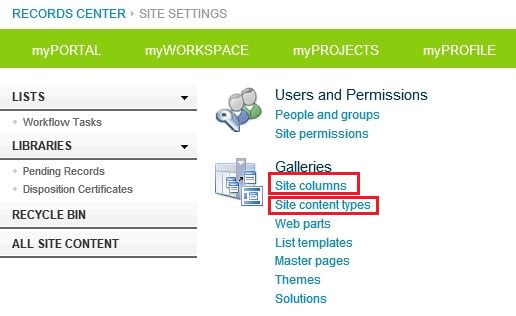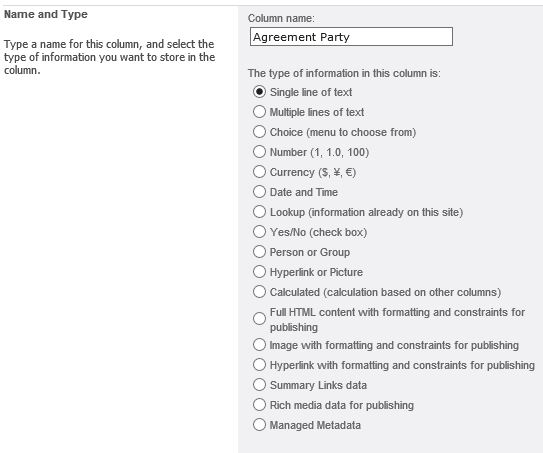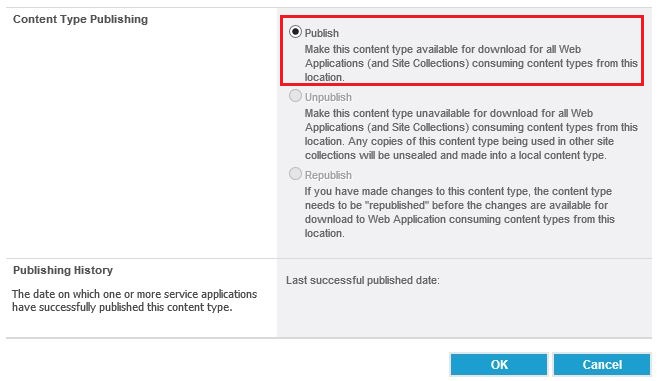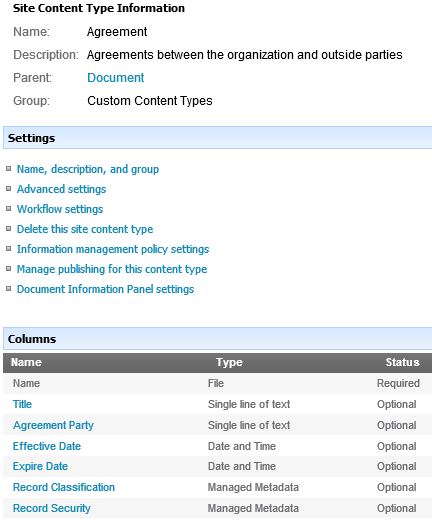Content Types are crucial to building an effective SharePoint site. Content Types can be used to build work areas and capture important metadata. Even without adding Collabware CLM functionality to SharePoint, understanding how to create effective Content Types will aid any organization. On top of this, Collabware CLM can utilize these Content Types and create a system that is not only more precise, but also more automated. We specifically built Collabware CLM Content Rules to enable users to create custom records management systems to fit the needs of their organizations.
However, before any of this can begin, understanding a Content Type is of premiere importance. Without a complete understanding of the foundation of many Collabware CLM functions, more complex sites will remain out of reach for organizations.
Document Types and SharePoint Content Types
Content Types are a relatively simple SharePoint structure, although their application can be complex. The most basic way to describe a Content Type is to call it a Document Type.
Content Types are meant to represent the different Document Types an organization has. This can be a very simple set of documents, such as Correspondence, Administrative Document and Financial Document. Even the most simple organization contains these Document Types, as they need to communicate, administrate and deal with money. But Document Types can be far more complex, spanning large organizations and can include Memos, Minutes, Agendas, Reports, Contracts, Agreements, Procedures, Policies, and more.
The important thing to understand is that Document Types fulfill a role in the organization and contain certain information. Let's take a very simple example of a document, the Agreement. An Agreement contains four standard pieces of information: Party One of the Agreement; Party Two of the Agreement; the date the Agreement comes into effect; the date the Agreement expires. This information can be found on pretty much any Agreement. The information that changes is the details of the Agreement, but there will always be the four noted pieces of information.
So we have our Agreement Content Type. It would look something like this:
Agreement
Party 1 (Text)
Party 2 (Text)
Begin Date (Date)
End Date (Date)
Metadata and SharePoint Columns
Metadata is a fairly common records management term that means, in essence, "information about information". Those four pieces of information that were noted for the Agreement Document Type would be considered Metadata. It is information about the Agreement that describes it in a unique way. Metadata can be simple or extremely robust. While we only identified four pieces of Metadata for the Agreement, there are potentially hundreds: Title, Author, Date of Creation, Date of Destruction, Format, Size, Word Count, Page Count, Location, Associated Department, Version Number, Font, Font Size, Colour of Text, Colour of Paper, Presence of Signature and many more.
In SharePoint, these pieces of information are called Columns. This is because if you created a spreadsheet of your Documents, you could fit a different piece of Metadata in each column.
Navigating SharePoint Content Types and Columns
In order to set up SharePoint Content Types and Columns, you must navigate to Site Settings. The two are located under Galleries.
 Site Settings
Site SettingsLet's take a look at the Content Types first.
 Content Types
Content Types
SharePoint comes with a number of default Content Types to fit different needs of organizations. You are free to use these default Content Types, although it should be noted that it is almost always better to develop your own Content Types to fit your own unique needs. Let's take a look at the Report Content Type SharePoint provides.
 Sample Content Type
Sample Content TypeAs you can see, the Report Content Type comes with several SharePoint Columns, or pieces of Metadata: Title, Report Description, Parent ID, Owner, Report Category, Report Status and the two CLM columns, Record Classification and Record Security. Keep in mind this is the default Content Type SharePoint provides; it may fit your needs for a Report, but it may not.
Let's move to SharePoint Columns now.
 Columns 1
Columns 1Once again, SharePoint has some default Columns for organizations to choose from. The important thing to understand here is that a SharePoint Column, basically a piece of Metadata, can be added to any Content Type you wish. Columns are simply a piece of information, they are not tied to any particular Content Type and, the Author Column can be added to almost any Content Type. But the Author Column isn't always useful. Going back to our Agreement example, the Author Column wouldn't be helpful in identifying one Agreement from another. Who wrote it doesn't matter; what matters is who it involves.
Creating Content Types and Columns
Creating a new Content Type or Column is quite simple. On both the Content Type and Column pages, there is a New button at the top. Let's create our Agreement Content Type.
 Create Content Type
Create Content TypeWhile you are on the Content Types page, click the Create button.
 New Content Type
New Content TypeThe first stage of Content Type creation is fairly straight forward, although it should be noted that setting the Parent Content Type to Document is highly recommended, as it is the standard Content Type that all others are based on. Let's move on to the next step.
 Content Type 2
Content Type 2As you can see, the Agreement Content Type already has a Title, Record Classification and Record Security. These are the SharePoint Columns that were populated from the Document Parent Content type chosen on the previous screen. But our Agreement is not yet complete, so let's add some more Columns. Normally, you will have to create a new Column, although if you know that the Column already exists, you can simply add it to the Content Type.
 Column Creation
Column CreationWhen creating a new Column, there are several different types to choose from. Most are self-explanatory, although the final choice, "Managed Metadata", is a set of terms that can be added to SharePoint on the Site Administration page. This requires administrative access. The Column Type "Choice" fulfills a similar role.
Since the organization doesn't require a column to identify itself, only three columns need to be added. The complete Content Type looks like this:
Once you've finalized your Content Type, it needs to be published across all SharePoint sites. This is the final step in creating a Content Type.
 Content Type Publish
Content Type PublishClick the "Manage publishing for this content type" option and then publish the Content Type.
 Publish
PublishApplying Content Types
Now that we are familiar with creating Content Types, let's discuss how these can be used. There are several basic ways you can begin to use your Content Types. But first, they must be accessible by your users. This means binding them to a library. Let's quickly walk through that.
Navigate to a library and click the Library Settings button.
 Library Settings
Library SettingsFrom here, you need to click the Advanced Settings button and enable Content Type Management.
 Advanced Settings
Advanced SettingsOnce you've enabled Content Type Management, go back to the Library Settings page and scroll until you see the new Content Type options. From here, it should be straight forward.
 Add Content Types
Add Content TypesHow to Use Content Types Effectively
There are many ways of using Content Types, but your organization should take the time to plan out the best way to structure your Team Sites and Libraries. You could create one massive Library that contains every Content Type, but this can be difficult to navigate and manage. What many organizations do is break up Libraries by segments of the organization, either by Department, Business Activity or sometimes by Content Type. This can be a very effective way to manage your content. For example, a Library dedicated entirely to Agreements could enable users to more quickly locate the Agreement they are looking for and ensure that all Agreements are managed the same way.
The best way to interact with Content Types to ensure that they are being used effectively is to imagine them as envelopes. An envelope contains information on the outside that pertains to the document inside. It has metadata: an addressee and a sender. Anyone who views the envelope can instantly assess the contents. But an envelope can contain just about anything; it doesn't have to be a letter. For example, it could be a key. The metadata on the outside still applies.
Now, going back to Content Types, the Agreement Content Type doesn't have to be used for only agreements. The metadata that we have defined for the Content Type may apply to other kinds of documents as well. For example, a document related to the agreement, an appendix, could be created with the Agreement Content Type. The metadata that needs to be attached to this appendix is the same as the agreement itself. The only difference between the agreement and the appendix is the Title. It's important not to confuse Content Types for actual documents. The Content Type is simply a tool to aid in the capture of Metadata; beyond this, it adds nothing to the document itself.
A Content Type that is broad enough can be used for many different purposes. For example, meetings create many different kinds of documents: agendas, minutes, reports and memos. These documents, while serving different purposes, can all share the same Metadata: Meeting Date, Department/Group, Topic. In this way, only one Meeting Content Type needs to be created, but it can be used in many different ways.
It is up to your organization to determine the structure of your SharePoint site, and this includes the Content Types you define. The most important thing to recognize is that Content Types make the capture of Metadata more simple for your users, and in turn, make searching and organizing your SharePoint sites easier.
Along with this, Collabware CLM uses Content Types to drive content capture through Content Rules. In other blogs, we explore How to Create Content Types in SharePoint and an Advanced Discussion on Content Types.
For more information or consultation , please feel free to reach out to us here.
And to see all the ways Collabware CLM adds features to SharePoint for compliant records management, access our full brochure:
![]()






